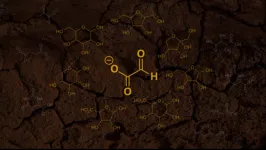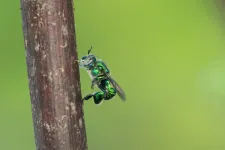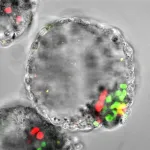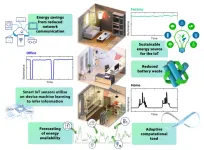(Press-News.org) LA JOLLA, CA— Two prominent origin-of-life chemists have published a new hypothesis for how the first sugars—which were necessary for life to evolve—arose on the early Earth.
In a paper that appeared on April 13, 2023, in the journal Chem, the chemists from Scripps Research and the Georgia Institute of Technology propose that key sugars needed for making early life forms could have emerged from reactions involving glyoxylate (C2HO3–), a relatively simple chemical that plausibly existed on the Earth before life evolved.
“We show that our new hypothesis has key advantages over the more traditional view that early sugars arose from the chemical formaldehyde,” says Ramanarayanan Krishnamurthy, PhD, a professor in the Department of Chemistry at Scripps Research.
Krishnamurthy’s co-author was Charles Liotta, PhD, Regents' Professor Emeritus at the Georgia Institute of Technology’s School of Chemistry and Biochemistry.
Origin-of-life chemists seek to explain how the basic molecular building blocks and reactions necessary for life could have arisen from the simple chemicals that were likely present on the “prebiotic” Earth. The overarching aim of the field is to answer the fundamental question of how our living planet came to be. But its discoveries also can inform—and have informed—many other fields, from atmospheric science and geology to synthetic biology and the search for life on other planets.
The three major classes of biological molecule whose availability needs to be explained by origin-of-life chemistry are: the amino acids that make up proteins, the nucleobases that make up the “letters” of DNA and RNA, and the sugars (also called carbohydrates) that are found throughout biology, including in the twisted backbone structure of DNA and RNA. According to the prevailing theories, amino acids probably arose from ammonia (NH3), while nucleobases arose from hydrogen cyanide (HCN).
The origin of sugars has been less clear. Many scientists believe the first sugars came from reactions involving formaldehyde (CH2O), but this theory has some drawbacks.
“The formaldehyde reactions proposed by this theory are quite messy—they have uncontrolled side reactions and other drawbacks due to formaldehyde’s high reactivity under the envisioned early-Earth conditions,” Liotta says.
The chemists’ proposed alternative is a “glyoxylose reaction” scenario in which glyoxylate first reacts with itself, forming a close cousin of formaldehyde known as glycolaldehyde. The researchers suggest that glyoxylate, glycolaldehyde, their byproducts and other simple compounds could have continued to react with one another, ultimately yielding simple sugars and other products—without the drawbacks of formaldehyde-based reactions.
Glyoxylate already has a prominent role in origin-of-life chemistry theories. Swiss chemist Albert Eschenmoser proposed in 2007 that a form of it might have been the source for multiple original biomolecules. Krishnamurthy and Furman University chemist Greg Springsteen, PhD, also suggested in a 2020 Nature Chemistry paper that glyoxylate could have helped initiate a primordial version of the modern (tricarboxylic acid) TCA cycle, a basic metabolic process found in most life forms on Earth.
Krishnamurthy and his team are currently working to demonstrate in the laboratory that the glyoxylose reaction scenario could indeed have yielded the first sugars.
“Such a demonstration would expand the role of glyoxylate as a versatile molecule in prebiotic chemistry and further stimulate the search for its own origin on the prebiotic Earth,” Krishnamurthy says.
The chemists are also looking into potential commercial applications of reactions that make glyoxylate, since these effectively consume CO2 and thus can be used to reduce CO2 levels, either locally in industrial settings or globally to combat global warming.
The study, “The Potential of Glyoxylate as a Prebiotic Source Molecule and a Reactant in Protometabolic Pathways – The Glyoxylose Reaction,” was supported by the NASA Exobiology Program NNH20ZA001N-EXO (20-EXO-0006) and by the National Science Foundation and the NASA Astrobiology Program under the Center for Chemical Evolution (CHE-1504217).
END
Where did the first sugars come from?
Origin-of-life chemists from Scripps Research and the Georgia Institute of Technology propose that glyoxylate could have been the original source of sugars on the “prebiotic” Earth
2023-04-13
ELSE PRESS RELEASES FROM THIS DATE:
Conservation: Red-throated loons avoid North Sea windfarms
2023-04-13
Offshore wind farms in the North Sea reduce the population of loons –fish-eating aquatic birds also known as divers – by 94% within a one-kilometre zone, according to new research published in Scientific Reports. The findings highlight the need to minimise the impact of offshore wind farms on seabirds, while balancing this effort with the demand for renewable energy.
Previous research has found that different seabird species respond to offshore windfarms differently – they may avoid the area which can lead to habitat displacement or they may be attracted to the area which can increase mortality via collisions with the turbines. However, it is difficult ...
Why orchid bees concoct their own fragrance
2023-04-13
Male bees display a remarkable passion for collecting scents: they deposit scents from various sources in special pockets on their hind legs, thus composing their own fragrance. This behaviour has been known since the 1960s. The reason why they do it has been the subject of much speculation just as long. Researchers from Ruhr University Bochum, Germany, in collaboration with colleagues from the University of California at Davis and the University of Florida at Fort Lauderdale, have finally solved the mystery. The bee fragrance serves as a sex attractant and increases the reproductive success of the males, as the team found out after three years ...
Uncovering hidden mitochondrial mutations in single cells
2023-04-13
A high-throughput single-cell single-mitochondrial genome sequencing technology known as iMiGseq has provided new insights into mutations of mitochondrial DNA (mtDNA) and offers a platform for assessing mtDNA editing strategies and genetic diagnosis of embryos prior to their implantation.
An international team of researchers, led by KAUST stem cell biologist Mo Li, has now quantitatively depicted the genetic maps of mtDNA in single human oocytes (immature eggs) and blastoids (stem cell-based synthetic embryos)[1]. This has revealed molecular features of rare mtDNA mutations that cause maternally inherited diseases.
Mitochondria, the ...
Effectiveness of COVID-19 mRNA vaccination for children and adolescents confirmed by multi-state study
2023-04-13
A multi-state study from the Centers for Disease Control and Prevention’s (CDC’s) VISION Network confirms that the Pfizer-BioNTech mRNA COVID-19 vaccine has provided children and adolescents, ages 5-17, with protection against both moderate and severe COVID-19 outcomes.
The study found that for 12-17 year olds, vaccine effectiveness was high against the Delta variant but lower during Omicron dominance, including BA.4 and BA.5. Due to the youngest age (5-11) group’s ineligibility for vaccination during Delta predominance, vaccine effectiveness could be estimated for these children only during the Omicron predominant ...
Four early-career cancer researchers earn prestigious annual award from NCCN Foundation
2023-04-13
PLYMOUTH MEETING, PA [April 13, 2023] — The National Comprehensive Cancer Network® (NCCN®) and the NCCN Foundation® today announced four winners for the 2023 NCCN Foundation Young Investigator Awards. These annual awards honor up-and-coming leaders in oncology research working to investigate and advance cancer care. The honorees will each receive up to $150,000 in funding for projects that will run over two years. The selection process is overseen by the NCCN Oncology Research Program (ORP) which will also provide oversight.
“It is a privilege to support these emerging innovators ...
Some people may be attracted to others over minimal similarities
2023-04-13
We are often attracted to others with whom we share an interest, but that attraction may be based on an erroneous belief that such shared interests reflect a deeper and more fundamental similarity—we share an essence—according to research published by the American Psychological Association.
“Our attraction to people who share our attributes is aided by the belief that those shared attributes are driven by something deep within us: one’s essence,” said lead author Charles Chu, PhD, an assistant professor at the Boston University Questrom School of Business. “To put it concretely, we like someone who agrees with us on a political issue, shares our music ...
The Biophysical Journal launches Postdoctoral Reviewer Program
2023-04-13
Today the Biophysical Journal is launching a new initiative, the Postdoctoral Reviewer Program. The program provides postdoctoral researchers in biophysics the opportunity to partner with Associate Editors and complete reviews that will be used in deciding whether articles will be accepted for publication.
Candidates for this program must be in a postdoctoral position during the 2023–2024 academic year and a member of BPS in good standing. Applications for the new program will be accepted through July 1 for a single-year term beginning in September 2023. Interested candidates can find more information about the program and application process online.
“I am extremely ...
Scientists create high-efficiency sustainable solar cells for IoT devices with AI-powered energy management
2023-04-13
Newcastle University researchers have created environmentally-friendly, high-efficiency photovoltaic cells that harness ambient light to power internet of Things (IoT) devices.
Led by Dr Marina Freitag, the research group from the from School of Natural and Environmental Sciences (SNES) created dye-sensitized photovoltaic cells based on a copper(II/I) electrolyte, achieving an unprecedented power conversion efficiency of 38% and 1.0V open-circuit voltage at 1,000 lux (fluorescent lamp). The cells are non-toxic and environmentally friendly, setting a new standard for sustainable ...
A sharper look at the M87 black hole
2023-04-13
The iconic image of the supermassive black hole at the center of M87—sometimes referred to as the “fuzzy, orange donut”—has gotten its first official makeover with the help of machine learning. The new image further exposes a central region that is larger and darker, surrounded by the bright accreting gas shaped like a “skinny donut.” The team used the data obtained by the Event Horizon Telescope (EHT) collaboration in 2017 and achieved, for the first time, the full resolution of the array.
In 2017, the EHT collaboration used a network of seven pre-existing telescopes ...
Gentle method allows for eco-friendly recycling of solar cells
2023-04-13
By using a new method, precious metals can be efficiently recovered from thin-film solar cells. This is shown by new research from Chalmers University of Technology, Sweden. The method is also more environmentally friendly than previous methods of recycling and paves the way for more flexible and highly efficient solar cells.
Today there are two mainstream types of solar cells. The most common is silicon-based and accounts for 90 percent of the market. The other type is called thin-film solar cells which in turn uses three main sub-technologies, one of which is known as CIGS ...
LAST 30 PRESS RELEASES:
Injectable breast ‘implant’ offers alternative to traditional surgeries
Neuroscientists devise formulas to measure multilingualism
New prostate cancer trial seeks to reduce toxicity without sacrificing efficacy
Geometry shapes life
A CRISPR screen reveals many previously unrecognized genes required for brain development and a new neurodevelopmental disorder
Hot flush treatment has anti-breast cancer activity, study finds
Securing AI systems against growing cybersecurity threats
Longest observation of an active solar region
Why nail-biting, procrastination and other self-sabotaging behaviors are rooted in survival instincts
Regional variations in mechanical properties of porcine leptomeninges
Artificial empathy in therapy and healthcare: advancements in interpersonal interaction technologies
Why some brains switch gears more efficiently than others
UVA’s Jundong Li wins ICDM’S 2025 Tao Li Award for data mining, machine learning
UVA’s low-power, high-performance computer power player Mircea Stan earns National Academy of Inventors fellowship
Not playing by the rules: USU researcher explores filamentous algae dynamics in rivers
Do our body clocks influence our risk of dementia?
Anthropologists offer new evidence of bipedalism in long-debated fossil discovery
Safer receipt paper from wood
Dosage-sensitive genes suggest no whole-genome duplications in ancestral angiosperm
First ancient human herpesvirus genomes document their deep history with humans
Why Some Bacteria Survive Antibiotics and How to Stop Them - New study reveals that bacteria can survive antibiotic treatment through two fundamentally different “shutdown modes”
UCLA study links scar healing to dangerous placenta condition
CHANGE-seq-BE finds off-target changes in the genome from base editors
The Journal of Nuclear Medicine Ahead-of-Print Tip Sheet: January 2, 2026
Delayed or absent first dose of measles, mumps, and rubella vaccination
Trends in US preterm birth rates by household income and race and ethnicity
Study identifies potential biomarker linked to progression and brain inflammation in multiple sclerosis
Many mothers in Norway do not show up for postnatal check-ups
Researchers want to find out why quick clay is so unstable
Superradiant spins show teamwork at the quantum scale
[Press-News.org] Where did the first sugars come from?Origin-of-life chemists from Scripps Research and the Georgia Institute of Technology propose that glyoxylate could have been the original source of sugars on the “prebiotic” Earth






